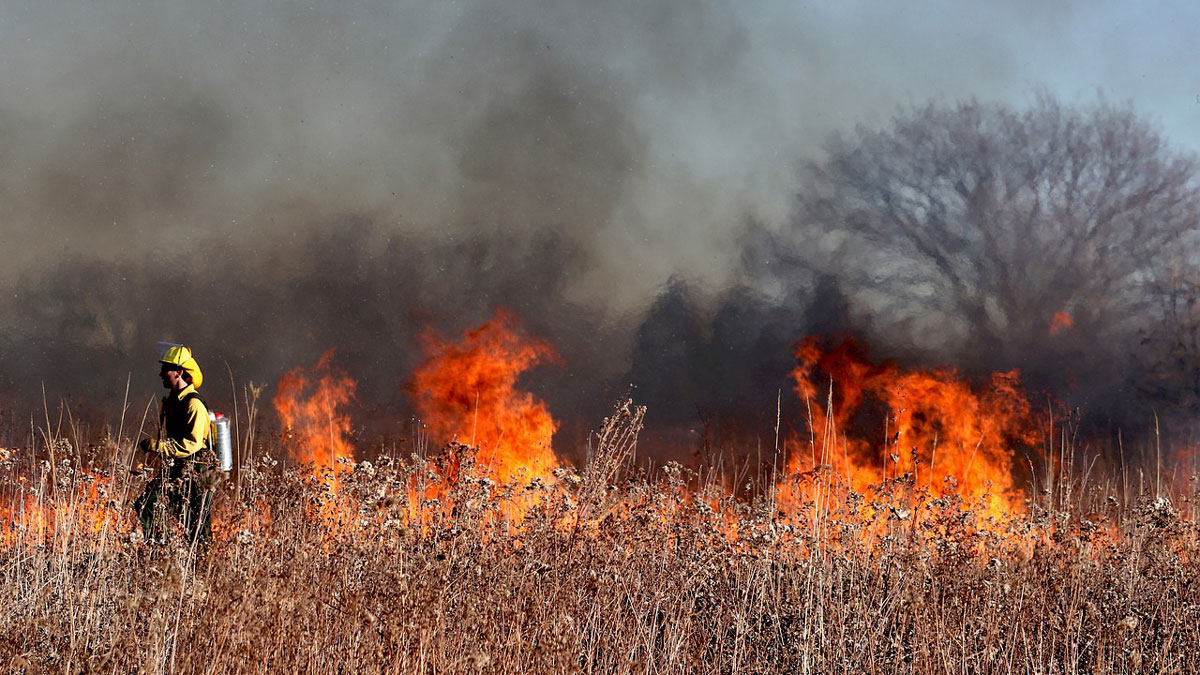Firefighters light and carefully monitor prescribed burns with the aim of preventing large wildfires. But climate change may narrow the window of opportunity for these prevention efforts, according to a new study published in Communications Earth and Environment.
The study’s authors used historical and projected trends to forecast future weather conditions in the western United States, then compared the results to burn plans that outline suitable conditions for prescribed fires. Their findings suggested that the number of days per year on which prescribed fires can be used safely may decrease by 17% in the coming decades.
Fighting Fire with Fire
Wildfires are becoming increasingly frequent and severe in the western United States, abetted by drought and human-ignited fires. Because more than 16 million homes in the western United States are located in fire-prone regions, wildfires threaten many people’s livelihoods and health.
In prescribed fires, fire crews burn dead and desiccated plants in a controlled fashion, reducing the amount of available fuel. When lightning or humans ignite a wildfire in the already-burned area, that fire is less likely to become an inferno.
“Prescribed fire practitioners want vegetation conditions to be in a Goldilocks range—not so damp that they prevent combustion, but not so dry that combustion is too intense.”
“Prescribed fires are an essential tool,” said Casey Teske, wildland fire science and ecology program lead at the National Park Service, who was not involved in the research. “They can help reduce hazardous fuels, restore and maintain ecosystem health and resiliency…and are oftentimes more cost-effective than other methods.”
But prescribed fires require certain conditions, explained Daniel Swain, a climate scientist at the University of California, Los Angeles and lead author of the new study.
“Prescribed fire practitioners want vegetation conditions to be in a Goldilocks range—not so damp that they prevent combustion, but not so dry that combustion is too intense,” he said. If the weather is too hot, too dry, or too windy, prescribed fires can rage out of control and cause the very damage they are meant to prevent.
In the western United States, prescribed burning is typically performed in the spring or fall, when weather conditions are more likely to be moderate. But with climate change leading to hotter, drier, and longer summers, the window of opportunity for prescribed fires is changing, too.
Longer Summers, Shorter Burn Windows
In the new study, Swain and his coauthors considered how climate change could alter the prescribed burn window. The researchers used climate data to trace temperature, humidity, and wind conditions from 1981 to 2020, then modeled future weather conditions until 2060. Next, they compared their weather models to burn plans from the National Park Service, the U.S. Forest Service, and other institutions to determine the number of days that could be suitable for prescribed fires.
The results suggested that 2°C (3.6°F) of global warming could reduce the number of suitable prescribed burn days by 17% (about 10 days) across the western United States. The drop is especially pronounced in spring and summer, when prescribed fire days are projected to decrease by 25% and 31%, respectively.
“Shrinking burn windows…will further challenge the safe and effective application of prescribed fires.”
“Many fire managers already find it difficult to burn as often as needed,” said John Kupfer, a landscape ecologist at the University of South Carolina who was not involved with the study. “Shrinking burn windows…will further challenge the safe and effective application of prescribed fires.”
The researchers also observed regional differences. Prescribed burn windows will narrow significantly in Nevada, Arizona, New Mexico, Utah, and Colorado. Along the central and Southern California coast, fire crews will lose up to a month of their current burn window. In the northwestern United States, however, the projected decline is weaker, and parts of Montana and the northern Rocky Mountains may even see an increase in potential prescribed fire days.
A New Winter Burn Window
As climate change reduces the number of suitable days in the spring and summer, winter may emerge as a more promising time for prescribed fires. According to the study, opportunities for prescribed fires in the wintertime could increase by 4% (slightly more than half a day) by 2060.
“Increasingly warm and dry conditions [in the winter] may push historically damp regions into an acceptable range by drying out fuels that were too wet to burn efficiently in the past,” Swain explained.
The researchers’ results suggested this will happen in the northern Rockies, inland Oregon, and Northern California. However, shifting prescribed fire efforts to the winter could be challenging because most federal firefighting employees work seasonally.
Overall, Teske noted, changing climate conditions will require some adjustment from fire management teams.
“Novel approaches to policies, funding, and implementation of fuels management projects using prescribed fire will need to be considered,” she said.
—Caroline Hasler (@carbonbasedcary), Science Writer

